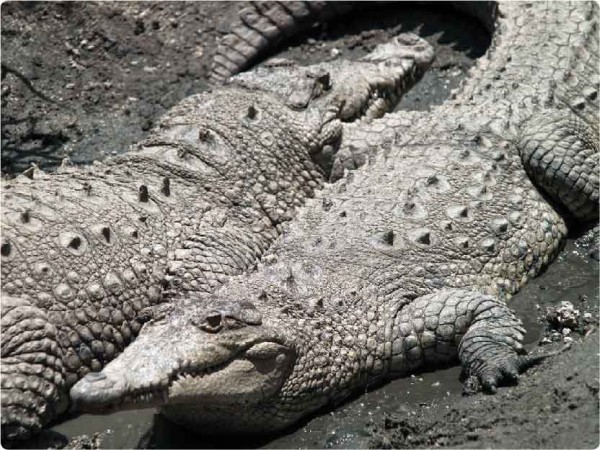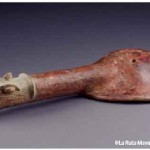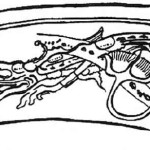Crocodiles, caimans and alligators in Mayan art & mythology of Guatemala
There are two species of crocodiles and one species of alligator in the Mayan regions of Guatemala, Belize, Honduras and Mexico.
Caiman crocodilus is a caiman, but considered an alligator (not a crocodile) despite its name “crocodilus.” The pattern of scales on this creature is very distinctive: no spikes or sharp spines but lots of raised bumps in a regular parallel pattern. The caiman has more color on its body than other crocodilians in Mesoamerica.
Crocodylus acutus can be found from the USA south through Mexico and Guatemala, so they would have been known to many Mesoamerican cultures. This is clearly one of the creatures that is the model for the crocodile tree.
Crocodylus moreletii has fewer bumps and spines than the others. Its habitat is only in Mexico, Belize and Guatemala.
The challenge is to take the Mayan renditions of crocodilians and identify which species has the supraorbital plate and which species gave rise to the exaggerated curled snout of pre-Columbian renditions.
In other words, if you have to choose between saying the Maya featured crocodiles or alligators, I would vote for crocodiles. This is a polite way of saying that any article or monograph that uses the word “alligator” (without footnoting at least the binominal of caiman) is using the typical North American fantasy that since there are alligators in Florida and crocodiles in Africa, that the Maya had only alligators in the region.
Other misidentifications
Since most Mayan scholars don’t live with a crocodile or caiman in their home, it is not surprising that these reptiles are often innocently misidentified. Several of the supposed crocodiles in Mayan murals are much more likely iguanas or other lizards.
Part of the cause for misidentifications is that many creatures in Mayan art are composites: part of one creature with attributes of another.
Yes, you can find surprisingly realistic crocodiles or caiman (the crocodile trees of Izapa, Chiapas, are pretty naturalistic for the body scales), but most crocodiles have distorted scrolled snouts and exaggerated supraorbital plates. Actually, “dragon” is a term that is not always inappropriate.
Pejelagarto
The pejelagarto, alligator gar fish, Atractosetus tropicus, looks more prehistoric than anything in Classic Mayan art. Fish do occur in Early Classic and Late Classic art (usually nibbling on a water lily pod), but I would be hard put to recognize a pejelagarto in Mayan murals or vase paintings.
Frankly, there is nothing on this fish (other than a long snout full of teeth) that even vaguely reminds me of an alligator. The spots are more feline-like than crocodilian.
Crocodiles in the Popol Vuh
Zipacana was the reptile who was one of the offspring of 7 Macaw (the false sun bird deity). This crocodile or alligator is already well known and the entire story is available in the many translations of the Popol Vuh.
Crocodiles in the stone sculpture of Copan, Honduras
Stela C at Copan clearly shows the top of the entire head with snout and teeth of a crocodile or caiman. Also the Copan Altar T has one or two crocodile-like creatures. Plus, there are several three-dimensional sculptures that have traditionally been considered as stylized crocodiles.
Crocodile sculptures along the Rio Usumacinta: Piedras Negras and Yaxchilan
At Piedras Negras, the natural rock outcrop that overlooks the Rio Usumacinta is in the form of a large saurian creature. At Yaxchilan you can also find representations of crocodiles or caimans, not surprising since Yaxchilan also fronts the Rio Usumacinta, a river filled with reptiles.
Crocodile remains found in royal Maya burials
Early Classic Burial 10 at Tikal included the remains of a crocodile and turtles. If you are a zooarchaeologist, surely you know the location of more archaeological finds of crocodilian remains in caches or burials.
Crocodile monsters as ceramic figurines
Louise Belanger, illustrator for the Lamanai Archaeological Project in Belize, has done many drawings of crocodilian figurines from the Mayan site of Lamanai. This Mayan city is next to a river that would have been filled with crocodiles 1,000 years ago (rivers in Belize still have crocodiles today). Indeed the name of the site is considered to mean “Submerged Crocodile.”
Heritage of crocodiles in the pre-Mayan art of the Olmec
F. Kent Reilly, Professor of Anthropology, shows examples of Olmec art with crocodilian representations. So it is not surprising to find crocodilians in the art of the Izapan culture, which is geographically and in time roughly partway between the Olmec and the Classic Maya. However, I am not convinced that the alligator gar fish is present in Olmec or Mayan art.
Dr. Nicholas M. Hellmuth is director of FLAAR Reports (Foundation for Latin American Anthropological Research). To view the list of sacred animals visit www.maya-archaeology.org or contact Dr. Hellmuth at frontdesk@flaar.org



Great article that I only just saw. I’ve seen C. acutus and Morelet’s but not the caiman. The crocs in the photo didn’t look familiar to me. I wondered what species they are.
Mythology where is it!
There are more alligators than people in Gautemala